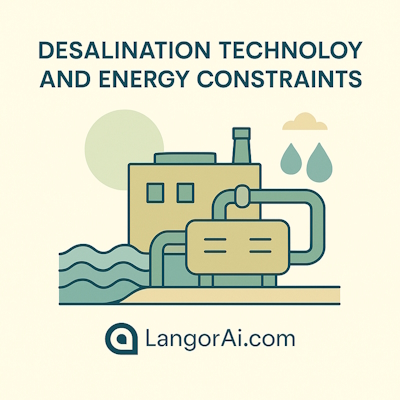
IELTS Reading Practice Test – Passage 1
Desalination Technology and Energy Constraints
As freshwater scarcity intensifies across many parts of the world, desalination—the process of extracting freshwater from seawater—has transitioned from an experimental idea to a vital component of national water strategies. Today, more than 300 million people receive at least part of their water supply from desalination plants. However, despite its growing importance, desalination remains a highly energy-intensive process, and analysts argue that its long-term sustainability is tied closely to how energy systems evolve over the next few decades.
There are two primary approaches used in modern desalination: thermal distillation and membrane-based reverse osmosis (RO). Thermal distillation, historically the older method, relies on heating seawater until it evaporates, followed by condensation of purified water vapor. This process is effective but consumes enormous amounts of heat energy, typically generated by fossil fuels. RO, by contrast, uses high pressure to force seawater through semi-permeable membranes that separate salt from water. RO systems require less heat than distillation; however, they rely on powerful pumps that demand substantial electrical power.
Improvements in RO membranes have been central to reducing the overall energy burden of desalination. Early RO membranes were thick, fragile, and prone to chemical degradation. Newer designs use ultra-thin polymer layers that increase filtration efficiency and decrease required pressure. At the same time, energy recovery devices—essentially turbines that capture and reuse pressure energy exiting the system—have cut electricity consumption by up to 40% in some facilities. Even so, desalination remains far more energy-intensive than treating river or groundwater.
The source of electricity used in desalination is a crucial factor in determining its environmental impact. In countries like Saudi Arabia and Qatar, where desalination is indispensable, power grids still rely heavily on natural gas and oil. As a result, desalination indirectly contributes to carbon emissions. In contrast, pilot plants in Spain, Australia, and Chile have integrated large-scale solar and wind farms directly with RO facilities. These operations demonstrate that low-carbon desalination is technically feasible, but cost and reliability barriers have slowed widespread adoption.
Another persistent challenge is the management of brine—the concentrated saltwater discharged after the desalination process. When released into the ocean without proper mixing, brine can create dense saline layers that sink to the seabed, harming marine organisms and altering local ecosystems. Some researchers are exploring ways to convert brine into valuable industrial materials, such as magnesium compounds and lithium salts, but these technologies have not yet proven cost-competitive.
Ultimately, desalination is neither a silver bullet nor an environmental catastrophe. Its value depends heavily on how intelligently it is integrated into broader water management systems. Experts emphasize that conservation, leak reduction, wastewater recycling, and agricultural efficiency should accompany desalination expansion. Without these measures, nations risk becoming trapped in what critics call the “energy–water paradox,” where solving water scarcity increases energy dependence and environmental strain.
Questions 1–6: True / False / Not Given
Questions 7–10: Multiple Choice
A) The color of the membranes
B) The source of electricity used
C) The temperature of seawater
D) The brand of the pumps
A) Recycling discarded salt
B) Capturing pressure energy
C) Cooling steam more rapidly
D) Reducing membrane thickness
A) Common worldwide
B) Mostly experimental
C) Illegal in many countries
D) More efficient than RO
A) Reduced agricultural demand
B) Greater dependence on energy systems
C) Immediate decline in water usage
D) Increased ocean biodiversity
Questions 11–14: Sentence Completion
NO MORE THAN TWO WORDS
Answer Key & Explanations
1 → FALSE — The text states desalination supplies many people, not most.
2 → TRUE — RO uses pressure, not heat; distillation uses more heat.
3 → TRUE — New membranes + energy recovery reduce consumption.
4 → FALSE — Renewable-powered plants are still limited and small-scale.
5 → TRUE — Brine harming seafloor ecosystems is clearly mentioned.
6 → NOT GIVEN — Research exists, but the text does not say it's “widely practiced.”
7 → B — Electricity source determines carbon footprint.
8 → B — They capture and reuse pressure energy.
9 → B — Described as pilot-scale, not widespread.
10 → B — Overreliance risks the energy–water paradox.
11 → pressure
12 → thin polymer
13 → marine
14 → energy-water
